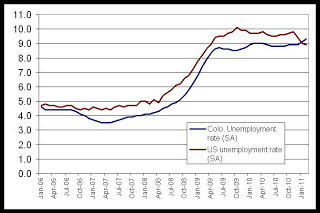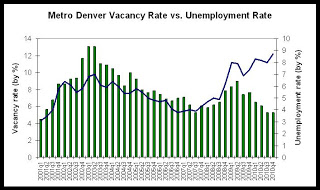(All unemployment rates quoted in this article are seasonally adjusted.)
In December, the national rate was at 9.4 percent while Colorado's rate was 8.9 percent. In January, however, Colorado's rate rose to 9.1 percent while the national rate fell to 9.0 percent. February widened the gap with Colorado's unemployment rate rising to 9.3 percent while the national rate fell to 8.9 percent.
The first graph shows the relationship between the national unemployment rate and the Colorado unemployment rate in recent years.

This reversal could have an effect on the demand for housing. As we've discussed here before, the vacancy rate had tended to move with the unemployment rate in recent years. Prior to the 2007-2009 recession, as unemployment increased, the vacancy rate increased as well. This was due to the connection between employment, household formation and the demand for rental housing.
The second graph shows this relationship:

Over the past 18 months, though, the vacancy rate has fallen in spite of a heightened unemployment rate. This change was unexpected, although it could at least be partially explained by the lack of new development in rental housing, and by the decline in the attractiveness of for-sale housing.
Another large factor has been the fact that household formation has continued at a strong pace in spite of stagnant economic and job growth in the area. This was no doubt helped along by the fact that Colorado was experiencing a lower unemployment rate than the nation in general. This encouraged workers to relocate to Colorado, and made Colorado a relatively attractive place for entry-level workers who, in many cases, are rental housing's target market.
With the reversal of this trend, the demand for rental housing may be impacted if it leads to a significant number of workers and households seeking employment outside the state. Vacancy data from the first and second quarters of this year will be helpful in determining if this change in unemployment rates will have much of an effect on the multifamily industry.
Also of interest: Feb 2011 employment summary
0 comments:
Post a Comment